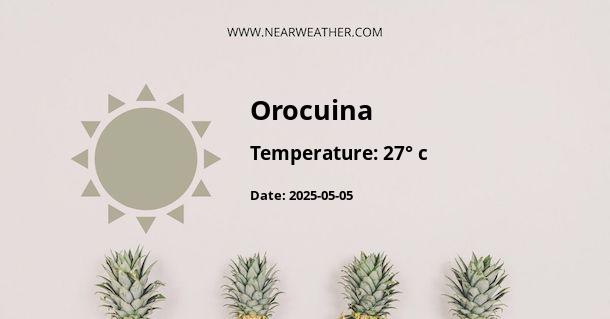Orocuina, Honduras - Climate and Weather Overview
Orocuina is a small municipality located in the Choluteca department of Honduras. The climate in Orocuina is classified as tropical savanna, with distinct wet and dry seasons. Understanding the weather patterns in Orocuina is essential for residents, visitors, and businesses operating in the region. This comprehensive guide provides a detailed overview of the climate and weather conditions in Orocuina throughout the year.
Temperature and Precipitation
The table below illustrates the average monthly temperature and precipitation in Orocuina.
| Month | Temperature (°C) | Precipitation (mm) |
|---|---|---|
| January | 28 | 3 |
| February | 29 | 0 |
| March | 29 | 0 |
| April | 29 | 10 |
| May | 28 | 100 |
| June | 27 | 140 |
| July | 27 | 130 |
| August | 27 | 140 |
| September | 27 | 190 |
| October | 27 | 200 |
| November | 27 | 40 |
| December | 27 | 10 |
From the data, it is evident that Orocuina experiences a significant amount of precipitation from May to October, with June to September being the wettest months. The temperatures remain relatively constant throughout the year, typically ranging from 27°C to 29°C.
Wet Season vs. Dry Season
Orocuina's climate can be characterized by distinct wet and dry seasons. The wet season, also known as the rainy season, typically occurs from May to October, whereas the dry season spans from November to April. The following chart visually represents the average monthly precipitation in Orocuina, highlighting the contrast between the wet and dry seasons.

As depicted in the chart, Orocuina receives a substantial amount of rainfall during the wet season, which is an important consideration for agricultural activities and water resource management in the region. Conversely, the dry season is characterized by significantly lower precipitation levels.
Climate Resilience and Adaptation
Given the pronounced wet and dry seasons in Orocuina, building climate resilience and implementing effective adaptation measures are crucial for the local community. Farmers and agricultural stakeholders need to develop strategies to cope with the intense rainfall during the wet season, such as implementing proper drainage systems and exploring suitable crop varieties that can withstand excess moisture. Additionally, water storage and conservation methods are essential to ensure a sustainable water supply during the dry season.
Extreme Weather Events
Orocuina, like many tropical regions, is susceptible to extreme weather events such as tropical storms and hurricanes. The municipality's geographical location makes it vulnerable to these natural phenomena, emphasizing the significance of preparedness and disaster response planning. Understanding historical weather patterns and trends is imperative for effectively managing and mitigating the impact of extreme weather events in Orocuina.
Conclusion
Orocuina's climate is characterized by a tropical savanna climate, featuring distinct wet and dry seasons. The region experiences consistent temperatures throughout the year, with notable variations in precipitation levels between the wet and dry seasons. As Orocuina continues to develop and adapt to its climate conditions, proactive measures and strategic planning will be instrumental in fostering resilience and sustainability in the face of varying weather patterns.
By comprehensively understanding the climate and weather patterns in Orocuina, stakeholders can make informed decisions and implement appropriate strategies to thrive in this unique environmental context.
A - Orocuina's Latitude is 13.481670 & Longitude is -87.105003.
A - Weather in Orocuina is 38° today.
A - Climate Conditions in Orocuina shows scattered clouds today.
A - Humidity in Orocuina is 34% today.
A - Wind speed in Orocuina is 22.21 km/h, flowing at 50° wind direction. today.
